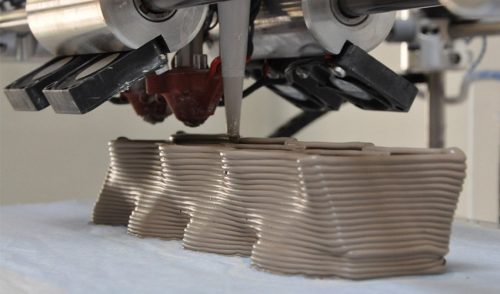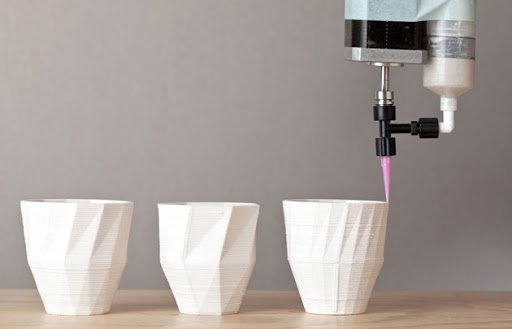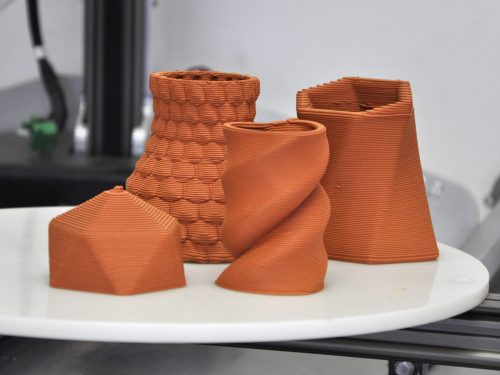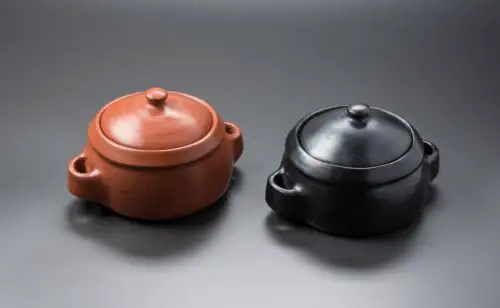Translated by Nick R
Did you have any idea that there is another (more futuristic) way to make ceramic pieces besides the traditional manual or artistic one? You can also create art pieces with 3D printers that achieve finishes as great as those made by hand.
This technique is not used by everyone; for professional potters having their hands connected to the clay represents a crucial moment; however, if you love art and technology, this is precisely what you are looking for, we promise it.
In this blog, we will discuss several issues of printing ceramic in 3D, from the basics of what a 3D printer is to complex topics such as the type of clay to use and what aspects you need to consider when 3D printing.

Table of Contents
What is a ceramic 3D printer?
A 3D printer is a device that can print figures in volume, that is, length, width, and height, from a computer design made in a 3D modeling software.
In other words, in a program on your computer, you can design an in-depth object such as a cup, and the printer will print it. It will not be printed on a sheet of paper as always, but in 3D entirely, and you will be able to hold it in your hands like a typical cup.
It sounds like magic, don’t you think? Some of us knew these machines already existed but to make plastic objects and similar materials, not for ceramics. Well, it’s great that now you can even make ceramics.
With no need to get your hands dirty, worry about whether you are doing it right, if the walls are too thick, if it is straight, or if it is symmetrical, you will be able to produce your own pieces in a very short time just by knowing how to use these computer programs,
These printers are relatively new on the market, so if you are amazed by what they can do now, imagine what they will be able to do in the future.
In a nutshell, what ceramic 3D printers do is build objects with all 3 dimensions: length, width, and height. They do so by adding layers upon layers until obtaining the desired object.

Type of pieces you can print in 3D
Technically, by using a 3D printer, you can print whatever you want. Here is where your imagination, creativity, and computer software skills come into play to create such great designs.
Within a single piece, you can play with various features: the designs or patterns, the size of these patterns, the spacing between them, and the movement they provide.
This is one of the most valuable aspects of 3D printing. You can create cool, weird, and very eye-catching shapes without all the work and effort that doing them manually and using lathing tools (like ribbon tools) or decorating techniques would require.
In addition, for a ceramic piece to have motion, you need to be very careful when modeling so that the clay can flow in your hands, which will make the artwork look the same, fluid. With a 3D printer, however, you don’t have to worry about that, you just have to do a proper job on the editing program, and if so, it will be perfect.
Although you employ your 3D printer to make any type of ceramic piece, the most common items are cups, vases, pots, pitchers, and all kinds of home decoration accessories.
Keep in mind that if you make your pieces through 3D printing, you will notice the difference from one that was made through common modeling techniques or in a potter’s wheel; the clay floors will be noticeable as when using the coiling technique, but they do not stick at any time.
If you want to use a 3D printer, your pieces will clearly look different from others on the market because of its layer-by-layer creation process, so that would be a big plus point in your favor.
Do not stick to the basics, but explore and exploit this practical and helpful machine as the printer is. You can make whatever you want, from a jewelry box for your mother to a long dinosaur for decorating your bedroom or living room. Why not turn the dinosaur into a lamp? There is no limit.

Types of clay you can use in a 3D printer
This is a huge question when it comes to 3D printing ceramic pieces, isn’t it? The doubt of whether you can use any type of clay or you need a special one comes in. Well, the answer will make you happy, you don’t need special clays!
You can use the clay commonly used for handmade pieces, yet mostly the following 4 that we list: bentonite clay, stoneware clay, terracotta clay, and porcelain paste.
What makes them perfect to be used in a 3D printer is their flexibility and plasticity, which makes them easy to model and allows them to come out of the machine’s nozzle smoothly.
To know which of the 4 types of clay you are selecting, take a look at its color and whether it has a low or high firing temperature, which is very important.
But regardless of which one you choose, never forget to knead the clay well before putting it into the printer’s extruder. If you do not knead enough, the clay may get stuck and cause the printer to jam, damaging your piece and forcing you start from scratch.
What should you consider to choosing your 3D printer?
This is a significant purchase and investment for your workshop or home, but you don’t need to worry, we will help you by explaining which aspects must be considered when choosing a 3D printer.
Size and space
Both the printer size and the space where you will place it in your workshop are key aspects to consider when picking your machine. So, the first thing we recommend is to be absolutely clear about where it will go and then measure that area to know the approximate size of the printer.
Once you know the exact size of the place, it is much easier for you to choose the printer according to its size. Though you should not only think about these two things, you also need to know what type of pieces you will make, whether very large or very small, because this will also affect the size of the printer.
If you plan to make cups, mugs, or ornaments that will not be too big, you can choose a small printer, but if you want to make big flowerpots, for example, you will have to choose a wider and taller one. It seems obvious, but pointing it out does not hurt, right?
Price
When it comes to price and quality, you better keep in mind that most cheap things are not always very reliable, and you may end up spending more money on repairs or buying a replacement soon after.
While you need to find a price-friendly printer, you could also take a look at buyer reviews or seller recommendations to ensure it is a great machine that will work well for you and won’t need extensive repairs in the future.
Remember that the pricing of machines like these depends on their size, features, appearance, and the manufacturer, so check these aspects carefully to determine if it’s overpriced or if that is what you are looking for exactly.
Still, keep in mind that these machines are by no means cheap; even the smallest of printers will be costly due to all the features it offers.
Lifespan
Sticking to the parameter of quality, now let’s talk about the lifespan of these machines. A decent ceramic 3D printer should average about 20,000 prints, but this is not a 100% accurate number because it depends on how you use it.
For example, if you don’t run it for long periods, it will likely cease to work as it did in the beginning and will damage faster. The best advice we can give you is to ask the manufacturer or seller what the average lifespan of a specific printer is. This will help you make the best decision.
You better ask whether the machine has a warranty against factory faults and what is the time span in case the printer begins to fail. You never know if it might have some defect. That way, you will save money on repairs.
Take full advantage of this tool. We promise that you will steal all the glances of potential buyers, or if you want to make gifts or simply decorate your home, you will turn your home into an art gallery.
_______________________________________________________________
With these tips, we declare this blog over. We hope we have helped you learn more about the world of ceramics and all the available modeling options besides the traditional manual one.
We hope we have been of great help for you to know what you should consider when choosing your printer and that this decision is much easier to make now. Dare to venture into this new 3D ceramic printing technique and never forget to exploit all its potential. What a fascinating tool it is, don’t you think?


